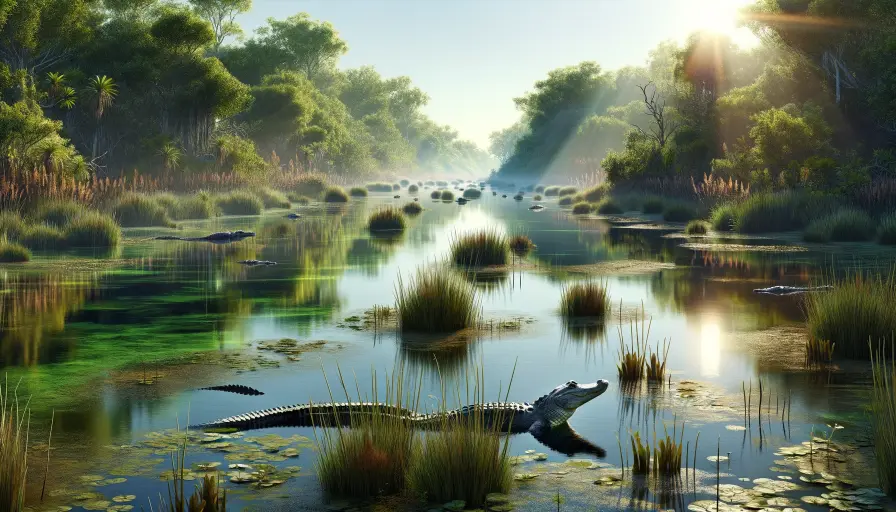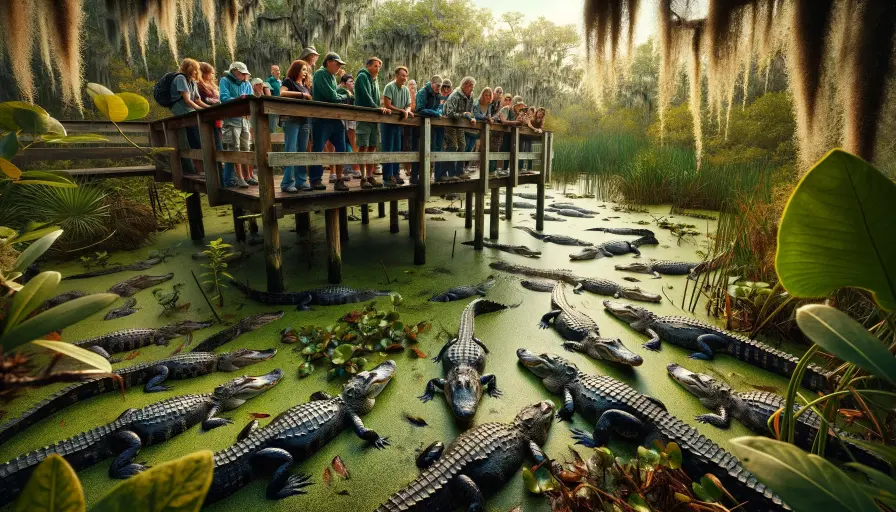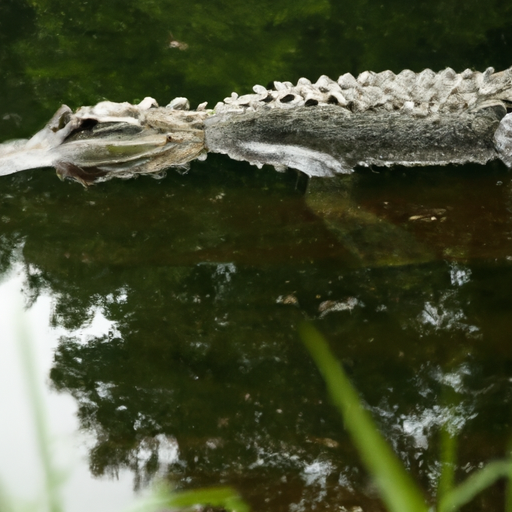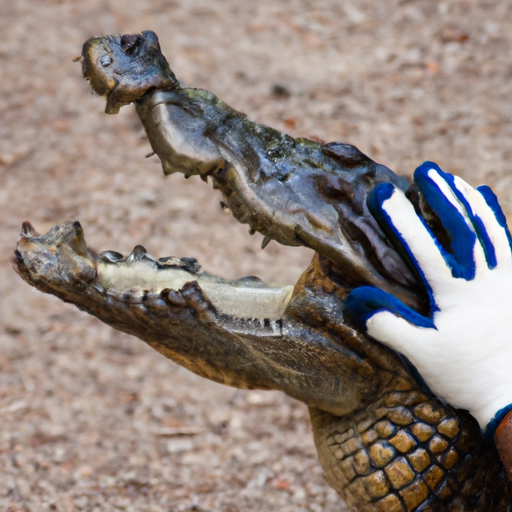So, you’ve been wondering if there are any alligators lurking in the waters of Delaware, huh? Well, let’s put your curiosity to rest.
While Delaware may not be known for its swamps and marshlands, the presence of alligators in this northeastern state is not completely unheard of. However, Delaware’s climate and geographical characteristics make it unlikely for alligators to establish permanent populations, and any encounters are typically transient occurrences.
While it may seem surprising, there have been occasional sightings and even captures of these ancient reptiles in Delaware, leaving residents and nature enthusiasts alike intrigued by the possibility of these elusive creatures calling the First State their home.
Geographical Information
Delaware’s Location
Delaware is a small state located on the East Coast of the United States. It is bordered by Maryland to the south and west, Pennsylvania to the north, and New Jersey to the east.
Despite its small size, Delaware boasts a diverse range of landscapes, including coastal areas, forests, and wetlands, making it an ideal habitat for various wildlife species.
Delaware’s Climate
Delaware experiences a humid subtropical climate, characterized by hot summers and mild winters. The average temperature in summer ranges from 75 to 85 degrees Fahrenheit, while winter temperatures average between 30 and 40 degrees Fahrenheit.
The state also receives a significant amount of rainfall throughout the year, which contributes to the wet and marshy habitats found in certain areas.
Natural Habitat
Alligator Habitats
Alligators typically inhabit warm, freshwater environments such as swamps, marshes, lakes, and rivers.
They are well-adapted to these habitats, with their ability to regulate body temperature and their excellent swimming skills.
Alligators are primarily found in southeastern states like Florida, Louisiana, and Georgia, where the climate and geography are most suitable for their survival.
Suitability of Delaware’s Environment
While Delaware does have wetlands and bodies of water, the state’s climate and topography are not entirely conducive to supporting alligator populations.
The cooler temperatures and the absence of consistent warm, freshwater habitats make it unlikely for alligators to establish permanent populations in Delaware.
However, there have been sporadic reports of alligator sightings in the state, indicating their transient presence.
Historical Presence of Alligators
Historically, it is believed that alligators did inhabit the Delaware River, which forms a natural border between Delaware and New Jersey.
Early records show occasional reports of alligators being spotted in the river during the 19th and early 20th centuries.
However, over time, changes in the ecosystem and human activities have significantly reduced the likelihood of alligator populations persisting in Delaware’s natural habitats.

Native Wildlife
Typical Wildlife in Delaware
Delaware is home to a diverse array of wildlife species, including mammals, birds, reptiles, and amphibians.
Common native wildlife found in the state includes white-tailed deer, raccoons, foxes, squirrels, various bird species, snakes, turtles, frogs, and salamanders.
These species have adapted to Delaware’s climate and habitats, establishing stable populations throughout the state.
Potential Interactions with Alligators
Given the unlikelihood of permanent alligator populations in Delaware, interactions between native wildlife and alligators are rare.
The native wildlife species have evolved without the presence of alligators and are not equipped to deal with potential interactions.
However, in the rare event of an alligator sighting or potential interaction, it is essential to exercise caution and contact local authorities to ensure the safety of both humans and wildlife.
Alligator Sightings
Public Sightings and Reports

Over the years, there have been occasional reports of alligator sightings in Delaware, particularly in the southern part of the state.
These reports primarily come from members of the public who claim to have seen alligators in various bodies of water.
While many reports turn out to be misidentifications or hoaxes, there have been instances where alligators were indeed spotted in Delaware.
Official Confirmation of Alligator Presence
The Delaware Department of Natural Resources and Environmental Control (DNREC) is responsible for confirming the presence of alligators in the state.
When credible reports are received, DNREC conducts investigations and on-site assessments to verify the existence of alligators.
In some cases, they have been able to confirm the presence of alligators, although it remains an uncommon occurrence.
Exotic Pets and Illegal Releases
Exotic Pet Ownership
The ownership of exotic pets, including alligators, is regulated in Delaware. It is illegal to own an alligator or any other reptile species without the necessary permits and licenses.
Exotic pet ownership laws are in place to ensure the safety of both the animals and the community. However, despite these regulations, there have been instances of individuals illegally owning alligators as pets in Delaware.
Illegally Released Alligators
Some alligator sightings in Delaware are a result of illegal releases by owners who can no longer care for these pets or who intentionally release them into the wild.
These illegal releases pose a threat to the local ecosystem and can disrupt the balance of native wildlife populations.
Moreover, alligators released into environments that are not suitable for their survival face numerous challenges and may not be able to adapt or thrive.
Alligator Migration
Natural Range of Alligators
Alligators are native to the southeastern United States, primarily inhabiting states along the Gulf Coast and the Atlantic Coast.
Their natural range spans from Florida in the south to North Carolina in the north, with Louisiana and Georgia as their core habitats.
Within this range, alligators are well adapted to the climate, ecosystems, and availability of suitable habitats.
Unlikely Migration to Delaware
The migration of alligators to Delaware from their natural range is highly unlikely. Alligators have specific habitat requirements, predominantly warm, freshwater environments.
The colder temperatures and limited availability of such habitats in Delaware make it improbable for alligators to migrate or establish sustainable populations in the state.
Any occasional sightings are more likely transient occurrences rather than permanent residents.
Potential Dangers
Alligator Attacks
While alligator attacks on humans are rare, they can potentially be dangerous for people and pets. Alligators are wild animals and, when provoked or threatened, can exhibit aggressive behavior.
It is important to remember that alligator attacks are extremely uncommon, and most instances occur when humans inadvertently enter alligator habitats or disturb the animals.
However, caution and awareness are crucial when encountering alligators, particularly in areas where they are known to be present.
Safety Measures
To ensure safety in alligator habitats, it is vital to observe some safety measures. Avoid swimming or recreating in bodies of water known to have alligator presence, as splashing can attract them.
Keep a safe distance from alligators and never approach them or attempt to feed them. It is also essential to respect wildlife and their habitats by not littering or leaving food scraps behind, as this can habituate alligators to human presence and increase the risk of potential conflicts.
Educational Awareness
Educating the public about alligator behavior, safety guidelines, and the importance of coexisting with wildlife is crucial.
Collaborations between agencies, educational institutions, and local communities can help disseminate accurate information and promote responsible wildlife viewing practices.
By fostering a greater understanding of alligators and their natural habitats, people can better appreciate these magnificent creatures while minimizing potential risks.
Conservation Efforts
Protection of Alligators
Alligators are protected under federal and state laws, including the Endangered Species Act and various wildlife conservation acts.
These laws ensure the preservation of alligators and their habitats, preventing illegal hunting, trade, and habitat destruction.
By protecting alligators, the overall ecosystem and biodiversity can also be safeguarded, contributing to the health and balance of Delaware’s natural heritage.
Conservation Initiatives
Various conservation initiatives focus on educating the public, conducting research, and implementing management strategies to protect alligators and their habitats.
Collaborative efforts between government agencies, research institutions, and non-profit organizations aim to conserve alligator populations, monitor their habitats, and raise awareness about the importance of biodiversity.
These initiatives play a crucial role in ensuring the long-term survival of alligators and promoting coexistence between humans and wildlife.
Misidentifications
Commonly Misidentified Reptiles
Alligator sightings in Delaware are sometimes misidentifications of other reptile species. Commonly misidentified reptiles include the American alligator’s smaller relative, the American crocodile, as well as various other species such as the common snapping turtle and large water snakes.
These misidentifications can occur due to similar physical characteristics or limited familiarity with different reptile species.
Distinguishing Alligators
There are several features that can help distinguish alligators from other reptiles. Alligators have a broad, rounded snout, while crocodiles have a more pointed snout.
Additionally, when an alligator’s mouth is closed, its upper teeth are usually not visible, whereas a crocodile’s upper teeth can be seen even when the mouth is shut.
Recognizing these subtle differences can aid in correctly identifying alligators and avoiding unnecessary alarm.
Practical Implications
Impacts on Local Communities
Alligator sightings in Delaware can have practical implications for local communities. While the occasional presence of alligators can attract attention and curiosity, it is essential to balance the interests of the community with the need to protect alligators and their habitats.
Encouraging responsible behavior, educating community members about safety measures, and fostering an appreciation for wildlife can help create a positive coexistence between humans and alligators.
Response of Authorities
The authorities in Delaware, particularly the DNREC, play a crucial role in responding to alligator sightings and addressing any potential concerns.
Through their investigations and assessments, they determine the credibility of reports and take appropriate action to ensure public safety.
Authorities also work to enforce regulations on exotic pet ownership and educate the community about the importance of preserving wildlife habitats and respecting alligators.
Balancing Nature and Human Activities
Finding a balance between nature and human activities is essential in areas where alligators are occasionally sighted.
Preserving natural habitats, conserving biodiversity, and adopting responsible practices can help minimize conflicts and promote coexistence.
By respecting wildlife and their habitats, Delaware can maintain its diverse ecosystems while allowing communities to enjoy and appreciate the natural beauty of the state.
Final Thoughts
In conclusion, while the occasional presence of alligators in Delaware may capture attention and spark curiosity, it is important to understand the context and practical implications surrounding these sightings.
Delaware’s climate and geographical characteristics make it unlikely for alligators to establish permanent populations, and any encounters are typically transient occurrences.
By promoting education, conservation efforts, and responsible behavior, Delaware can foster a harmonious relationship between humans and wildlife, ensuring the preservation of its natural heritage for generations to come.




